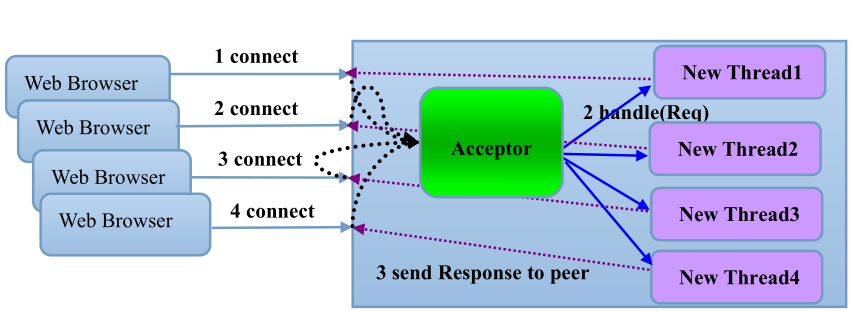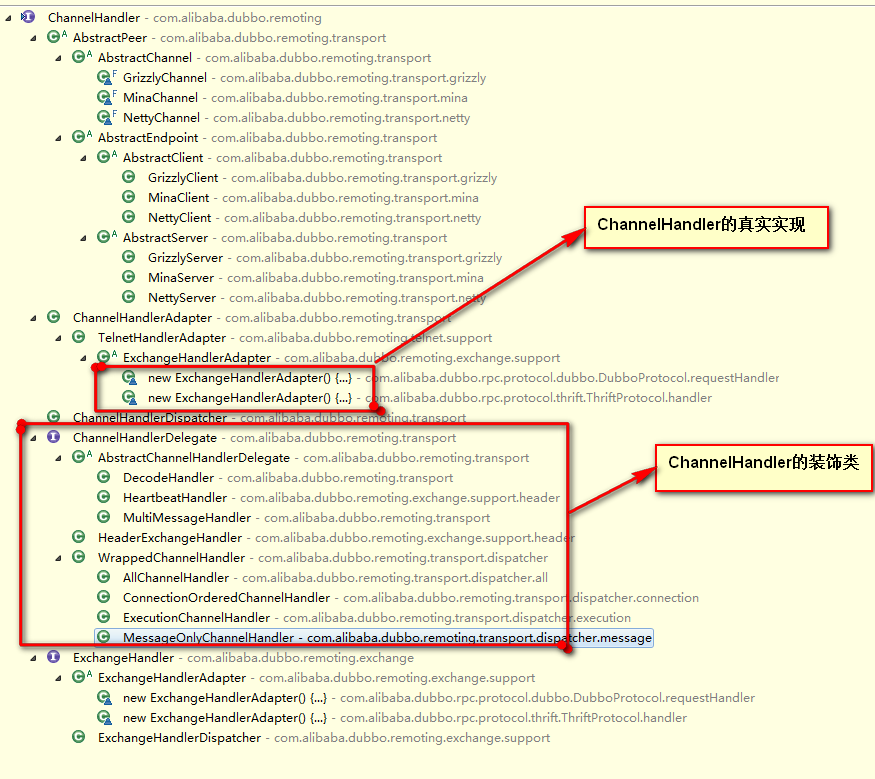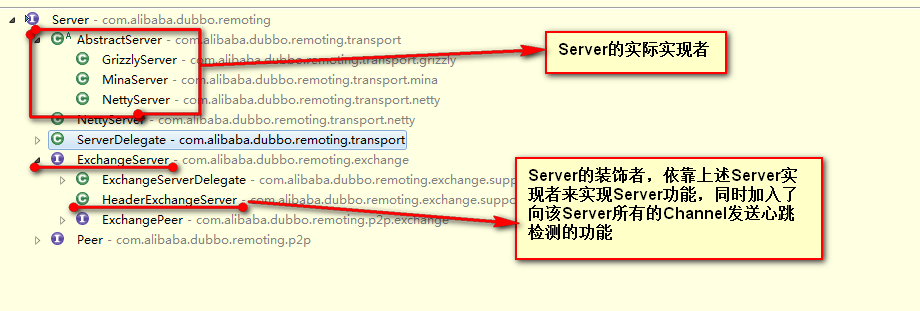#1 系列目录
#2 NIO通信层的抽象
目前dubbo已经集成的有netty、mina、grizzly。先来通过案例简单了解下netty、mina编程(grizzly没有了解过)
##2.1 netty和mina的简单案例
netty原本是jboss开发的,后来单独出来了,所以会有两种版本就是org.jboss.netty和io.netty两种包类型的,而dubbo内置的是前者。目前还不是很熟悉,可能稍有差别,但是整体大概都是一样的。
我们先来看下io.netty的案例:
public static void main(String[] args){
EventLoopGroup bossGroup=new NioEventLoopGroup();
EventLoopGroup workerGroup = new NioEventLoopGroup();
try {
ServerBootstrap serverBootstrap=new ServerBootstrap();
serverBootstrap.group(bossGroup,workerGroup)
.channel(NioServerSocketChannel.class)
.childHandler(new ChannelInitializer<SocketChannel>() {
@Override
protected void initChannel(SocketChannel ch) throws Exception {
ch.pipeline().addLast(new TcpServerHandler());
}
});
ChannelFuture f=serverBootstrap.bind(8080).sync();
f.channel().closeFuture().sync();
} catch (InterruptedException e) {
e.printStackTrace();
}finally {
workerGroup.shutdownGracefully();
bossGroup.shutdownGracefully();
}
}
mina的案例:
public static void main(String[] args) throws IOException{
IoAcceptor acceptor = new NioSocketAcceptor();
acceptor.getFilterChain().addLast("codec",new ProtocolCodecFilter(
new TextLineCodecFactory(Charset.forName("UTF-8"),"\r\n", "\r\n")));
acceptor.setHandler(new TcpServerHandler());
acceptor.bind(new InetSocketAddress(8080));
}
两者都是使用Reactor模型结构。而最原始BIO模型如下:

每来一个Socket连接都为该Socket创建一个线程来处理。由于总线程数有限制,导致Socket连接受阻,所以BIO模型并发量并不大
Rector多线程模型如下,更多信息见Netty系列之Netty线程模型:

用一个boss线程,创建Selector,用于不断监听Socket连接、客户端的读写操作等
用一个线程池即workers,负责处理Selector派发的读写操作。
由于boss线程可以接收更多的Socket连接,同时可以充分利用线程池中的每个线程,减少了BIO模型下每个线程为单独的socket的等待时间。
##2.2 服务器端如何集成netty和mina
先来简单总结下上述netty和mina的相似之处,然后进行抽象概括成接口
-
1 各自有各自的编程启动方式
-
2 都需要各自的ChannelHandler实现,用于处理各自的Channel或者IoSession的连接、读写等事件。
对于netty来说: 需要继承org.jboss.netty.channel.SimpleChannelHandler(或者其他方式),来处理org.jboss.netty.channel.Channel的连接读写事件
对于mina来说:需要继承org.apache.mina.common.IoHandlerAdapter(或者其他方式),来处理org.apache.mina.common.IoSession的连接读写事件
为了统一上述问题,dubbo需要做如下事情:
-
1 定义dubbo的com.alibaba.dubbo.remoting.Channel接口
-
1.1 针对netty,上述Channel的实现为NettyChannel,内部含有一个netty自己的org.jboss.netty.channel.Channel channel对象,即该com.alibaba.dubbo.remoting.Channel接口的功能实现全部委托为底层的org.jboss.netty.channel.Channel channel对象来实现
-
1.2 针对mina,上述Channel实现为MinaChannel,内部包含一个mina自己的org.apache.mina.common.IoSession session对象,即该com.alibaba.dubbo.remoting.Channel接口的功能实现全部委托为底层的org.apache.mina.common.IoSession session对象来实现
-
-
2 定义自己的com.alibaba.dubbo.remoting.ChannelHandler接口,用于处理com.alibaba.dubbo.remoting.Channel接口的连接读写事件,如下所示
public interface ChannelHandler { void connected(Channel channel) throws RemotingException; void disconnected(Channel channel) throws RemotingException; void sent(Channel channel, Object message) throws RemotingException; void received(Channel channel, Object message) throws RemotingException; void caught(Channel channel, Throwable exception) throws RemotingException; }-
2.1 先定义用于处理netty的NettyHandler,需要按照netty的方式继承netty的org.jboss.netty.channel.SimpleChannelHandler,此时NettyHandler就可以委托dubbo的com.alibaba.dubbo.remoting.ChannelHandler接口实现来完成具体的功能,在交给com.alibaba.dubbo.remoting.ChannelHandler接口实现之前,需要先将netty自己的org.jboss.netty.channel.Channel channel转化成上述的NettyChannel,见NettyHandler
public void channelConnected(ChannelHandlerContext ctx, ChannelStateEvent e) throws Exception { NettyChannel channel = NettyChannel.getOrAddChannel(ctx.getChannel(), url, handler); try { if (channel != null) { channels.put(NetUtils.toAddressString((InetSocketAddress) ctx.getChannel().getRemoteAddress()), channel); } handler.connected(channel); } finally { NettyChannel.removeChannelIfDisconnected(ctx.getChannel()); } } @Override public void channelDisconnected(ChannelHandlerContext ctx, ChannelStateEvent e) throws Exception { NettyChannel channel = NettyChannel.getOrAddChannel(ctx.getChannel(), url, handler); try { channels.remove(NetUtils.toAddressString((InetSocketAddress) ctx.getChannel().getRemoteAddress())); handler.disconnected(channel); } finally { NettyChannel.removeChannelIfDisconnected(ctx.getChannel()); } } -
2.2 先定义用于处理mina的MinaHandler,需要按照mina的方式继承mina的org.apache.mina.common.IoHandlerAdapter,此时MinaHandler就可以委托dubbo的com.alibaba.dubbo.remoting.ChannelHandler接口实现来完成具体的功能,在交给com.alibaba.dubbo.remoting.ChannelHandler接口实现之前,需要先将mina自己的org.apache.mina.common.IoSession转化成上述的MinaChannel,见MinaHandler
public void sessionOpened(IoSession session) throws Exception { MinaChannel channel = MinaChannel.getOrAddChannel(session, url, handler); try { handler.connected(channel); } finally { MinaChannel.removeChannelIfDisconnectd(session); } } @Override public void sessionClosed(IoSession session) throws Exception { MinaChannel channel = MinaChannel.getOrAddChannel(session, url, handler); try { handler.disconnected(channel); } finally { MinaChannel.removeChannelIfDisconnectd(session); } }
-
做了上述事情之后,全部逻辑就统一到dubbo自己的com.alibaba.dubbo.remoting.ChannelHandler接口如何来处理自己的com.alibaba.dubbo.remoting.Channel接口。
这就需要看下com.alibaba.dubbo.remoting.ChannelHandler接口的实现有哪些:

-
3 定义Server接口用于统一大家的启动流程
先来看下整体的Server接口实现情况

如NettyServer的启动流程: 按照netty自己的API启动方式,然后依据外界传递进来的com.alibaba.dubbo.remoting.ChannelHandler接口实现,创建出NettyHandler,最终对用户的连接请求的处理全部交给NettyHandler来处理,NettyHandler又交给了外界传递进来的com.alibaba.dubbo.remoting.ChannelHandler接口实现。
至此就将所有底层不同的通信实现全部转化到了外界传递进来的com.alibaba.dubbo.remoting.ChannelHandler接口的实现上了。
而上述Server接口的另一个分支实现HeaderExchangeServer则充当一个装饰器的角色,为所有的Server实现增添了如下功能:
向该Server所有的Channel依次进行心跳检测:
- 如果当前时间减去最后的读取时间大于heartbeat时间或者当前时间减去最后的写时间大于heartbeat时间,则向该Channel发送一次心跳检测
- 如果当前时间减去最后的读取时间大于heartbeatTimeout,则服务器端要关闭该Channel,如果是客户端的话则进行重新连接(客户端也会使用这个心跳检测任务)
##2.3 客户端如何集成netty和mina
服务器端了解了之后,客户端就也非常清楚了,整体类图如下:

如NettyClient在使用netty的API开启客户端之后,仍然使用NettyHandler来处理。还是最终转化成com.alibaba.dubbo.remoting.ChannelHandler接口实现上了。
HeaderExchangeClient和上面的HeaderExchangeServer非常类似,就不再提了。
我们可以看到这样集成完成之后,就完全屏蔽了底层通信细节,将逻辑全部交给了com.alibaba.dubbo.remoting.ChannelHandler接口的实现上了。从上面我们也可以看到,该接口实现也会经过层层装饰类的包装,才会最终交给底层通信。
如HeartbeatHandler装饰类:
public void sent(Channel channel, Object message) throws RemotingException {
setWriteTimestamp(channel);
handler.sent(channel, message);
}
public void received(Channel channel, Object message) throws RemotingException {
setReadTimestamp(channel);
if (isHeartbeatRequest(message)) {
Request req = (Request) message;
if (req.isTwoWay()) {
Response res = new Response(req.getId(), req.getVersion());
res.setEvent(Response.HEARTBEAT_EVENT);
channel.send(res);
if (logger.isInfoEnabled()) {
int heartbeat = channel.getUrl().getParameter(Constants.HEARTBEAT_KEY, 0);
if(logger.isDebugEnabled()) {
logger.debug("Received heartbeat from remote channel " + channel.getRemoteAddress()
+ ", cause: The channel has no data-transmission exceeds a heartbeat period"
+ (heartbeat > 0 ? ": " + heartbeat + "ms" : ""));
}
}
}
return;
}
if (isHeartbeatResponse(message)) {
if (logger.isDebugEnabled()) {
logger.debug(
new StringBuilder(32)
.append("Receive heartbeat response in thread ")
.append(Thread.currentThread().getName())
.toString());
}
return;
}
handler.received(channel, message);
}
就会拦截那些上述提到的心跳检测请求。更新该Channel的最后读写时间。
##2.4 同步调用和异步调用的实现
首先设想一下我们目前的通信方式,使用netty mina等异步事件驱动的通信框架,将Channel中信息都分发到Handler中去处理了,Handler中的send方法只负责不断的发送消息,receive方法只负责不断接收消息,这时候就产生一个问题:
客户端如何对应同一个Channel的接收的消息和发送的消息之间的匹配呢?
这也很简单,就需要在发送消息的时候,必须要产生一个请求id,将调用的信息连同id一起发给服务器端,服务器端处理完毕后,再将响应信息和上述请求id一起发给客户端,这样的话客户端在接收到响应之后就可以根据id来判断是针对哪次请求的响应结果了。
来看下DubboInvoker中的具体实现
boolean isAsync = RpcUtils.isAsync(getUrl(), invocation);
boolean isOneway = RpcUtils.isOneway(getUrl(), invocation);
int timeout = getUrl().getMethodParameter(methodName, Constants.TIMEOUT_KEY,Constants.DEFAULT_TIMEOUT);
if (isOneway) {
boolean isSent = getUrl().getMethodParameter(methodName, Constants.SENT_KEY, false);
currentClient.send(inv, isSent);
RpcContext.getContext().setFuture(null);
return new RpcResult();
} else if (isAsync) {
ResponseFuture future = currentClient.request(inv, timeout) ;
RpcContext.getContext().setFuture(new FutureAdapter<Object>(future));
return new RpcResult();
} else {
RpcContext.getContext().setFuture(null);
return (Result) currentClient.request(inv, timeout).get();
}
- 如果不需要返回值,直接使用send方法,发送出去,设置当期和线程绑定RpcContext的future为null
- 如果需要异步通信,使用request方法构建一个ResponseFuture,然后设置到和线程绑定RpcContext中
- 如果需要同步通信,使用request方法构建一个ResponseFuture,阻塞等待请求完成
可以看到的是它把ResponseFuture设置到与当前线程绑定的RpcContext中了,如果我们要获取异步结果,则需要通过RpcContext来获取当前线程绑定的RpcContext,然后就可以获取Future对象。如下所示:
String result1 = helloService.hello("World");
System.out.println("result :"+result1);
System.out.println("result : "+RpcContext.getContext().getFuture().get());
当设置成异步请求的时候,result1则为null,然后通过RpcContext来获取相应的值。
然后我们来看下异步请求的整个实现过程,即上述currentClient.request方法的具体内容:
public ResponseFuture request(Object request, int timeout) throws RemotingException {
// create request.
Request req = new Request();
req.setVersion("2.0.0");
req.setTwoWay(true);
req.setData(request);
DefaultFuture future = new DefaultFuture(channel, req, timeout);
try{
channel.send(req);
}catch (RemotingException e) {
future.cancel();
throw e;
}
return future;
}
-
第一步:创建出一个request对象,创建过程中就自动产生了requestId,如下
public class Request { private final long mId; private static final AtomicLong INVOKE_ID = new AtomicLong(0); public Request() { mId = newId(); } private static long newId() { // getAndIncrement()增长到MAX_VALUE时,再增长会变为MIN_VALUE,负数也可以做为ID return INVOKE_ID.getAndIncrement(); } } -
第二步:根据request请求封装成一个DefaultFuture对象,通过该对象的get方法就可以获取到请求结果。该方法会阻塞一直到请求结果产生。同时DefaultFuture对象会被存至DefaultFuture类如下结构中:
private static final Map<Long, DefaultFuture> FUTURES = new ConcurrentHashMap<Long, DefaultFuture>();key就是请求id
-
第三步:将上述请求对象发送给服务器端,同时将DefaultFuture对象返给上一层函数,即DubboInvoker中,然后设置到当前线程中
-
第四步:用户通过RpcContext来获取上述DefaultFuture对象来获取请求结果,会阻塞至服务器端返产生结果给客户端
-
第五步:服务器端产生结果,返回给客户端会在客户端的handler的receive方法中接收到,接收到之后判别接收的信息是Response后,
static void handleResponse(Channel channel, Response response) throws RemotingException { if (response != null && !response.isHeartbeat()) { DefaultFuture.received(channel, response); } }就会根据response的id从上述FUTURES结构中查出对应的DefaultFuture对象,并把结果设置进去。此时DefaultFuture的get方法则不再阻塞,返回刚刚设置好的结果。
至此异步通信大致就了解了,但是我们会发现一个问题:
当某个线程多次发送异步请求时,都会将返回的DefaultFuture对象设置到当前线程绑定的RpcContext中,就会造成了覆盖问题,如下调用方式:
String result1 = helloService.hello("World");
String result2 = helloService.hello("java");
System.out.println("result :"+result1);
System.out.println("result :"+result2);
System.out.println("result : "+RpcContext.getContext().getFuture().get());
System.out.println("result : "+RpcContext.getContext().getFuture().get());
即异步调用了hello方法,再次异步调用,则前一次的结果就被冲掉了,则就无法获取前一次的结果了。必须要调用一次就立马将DefaultFuture对象获取走,以免被冲掉。即这样写:
String result1 = helloService.hello("World");
Future<String> result1Future=RpcContext.getContext().getFuture();
String result2 = helloService.hello("java");
Future<String> result2Future=RpcContext.getContext().getFuture();
System.out.println("result :"+result1);
System.out.println("result :"+result2);
System.out.println("result : "+result1Future.get());
System.out.println("result : "+result2Future.get());
最后来张dubbo的解释图片:

#3 通信层与dubbo的结合
从上面可以了解到如何对不同的通信框架进行抽象,屏蔽底层细节,统一将逻辑交给ChannelHandler接口实现来处理。然后我们就来了解下如何与dubbo的业务进行对接,也就是在什么时机来使用上述通信功能:
##3.1 服务的发布过程使用通信功能
如DubboProtocol在发布服务的过程中:
-
1 DubboProtocol中有一个如下结构
Map<String, ExchangeServer> serverMap在发布一个服务的时候会先根据服务的url获取要发布的服务所在的host和port,以此作为key来从上述结构中寻找是否已经有对应的ExchangeServer(上面已经说明)。
-
2 如果没有的话,则会创建一个,创建过程如下:
ExchangeServer server = Exchangers.bind(url, requestHandler);其中requestHandler就是DubboProtocol自身实现的ChannelHandler。
获取一个ExchangeServer,它的实现主要是Server的装饰类,依托外部传递的Server来实现Server功能,而自己加入一些额外的功能,如ExchangeServer的实现HeaderExchangeServer,就是加入了心跳检测的功能。
所以此时我们可以自定义扩展功能来实现Exchanger。接口定义如下:
@SPI(HeaderExchanger.NAME) public interface Exchanger { @Adaptive({Constants.EXCHANGER_KEY}) ExchangeServer bind(URL url, ExchangeHandler handler) throws RemotingException; @Adaptive({Constants.EXCHANGER_KEY}) ExchangeClient connect(URL url, ExchangeHandler handler) throws RemotingException; }默认使用的就是HeaderExchanger,它创建的ExchangeServer是HeaderExchangeServer如下所示:
public class HeaderExchanger implements Exchanger { public static final String NAME = "header"; public ExchangeClient connect(URL url, ExchangeHandler handler) throws RemotingException { return new HeaderExchangeClient(Transporters.connect(url, new DecodeHandler(new HeaderExchangeHandler(handler)))); } public ExchangeServer bind(URL url, ExchangeHandler handler) throws RemotingException { return new HeaderExchangeServer(Transporters.bind(url, new DecodeHandler(new HeaderExchangeHandler(handler)))); } }HeaderExchangeServer仅仅是一个Server接口的装饰类,需要依托外部传递Server实现来完成具体的功能。此Server实现可以是netty也可以是mina等。所以我们可以自定义Transporter实现来选择不同底层通信框架,接口定义如下:
@SPI("netty") public interface Transporter { @Adaptive({Constants.SERVER_KEY, Constants.TRANSPORTER_KEY}) Server bind(URL url, ChannelHandler handler) throws RemotingException; @Adaptive({Constants.CLIENT_KEY, Constants.TRANSPORTER_KEY}) Client connect(URL url, ChannelHandler handler) throws RemotingException; }默认采用netty实现,如下:
public class NettyTransporter implements Transporter { public static final String NAME = "netty"; public Server bind(URL url, ChannelHandler listener) throws RemotingException { return new NettyServer(url, listener); } public Client connect(URL url, ChannelHandler listener) throws RemotingException { return new NettyClient(url, listener); } }至此就到了我们上文介绍的内容了。同时DubboProtocol的ChannelHandler实现经过层层装饰器包装,最终传给底层通信Server。
客户端发送请求给服务器端时,底层通信Server会将请求经过层层处理最终传递给DubboProtocol的ChannelHandler实现,在该实现中,会根据请求参数找到对应的服务器端本地Invoker,然后执行,再将返回结果通过底层通信Server发送给客户端。
##3.2 客户端的引用服务使用通信功能
在DubboProtocol引用服务的过程中:
-
1 使用如下方式创建client
ExchangeClient client=Exchangers.connect(url ,requestHandler);requestHandler还是DubboProtocol中ChannelHandler实现。
和Server类似,我们可以通过自定义Exchanger实现来创建出不同功能的ExchangeClient。默认的Exchanger实现是HeaderExchanger
public class HeaderExchanger implements Exchanger { public static final String NAME = "header"; public ExchangeClient connect(URL url, ExchangeHandler handler) throws RemotingException { return new HeaderExchangeClient(Transporters.connect(url, new DecodeHandler(new HeaderExchangeHandler(handler)))); } public ExchangeServer bind(URL url, ExchangeHandler handler) throws RemotingException { return new HeaderExchangeServer(Transporters.bind(url, new DecodeHandler(new HeaderExchangeHandler(handler)))); } }创建出来的ExchangeClient是HeaderExchangeClient,它也是Client的包装类,仅仅在Client外层加上心跳检测的功能,向它所连接的服务器端发送心跳检测。
HeaderExchangeClient需要外界给它传一个Client实现,这是由Transporter接口实现来定的,默认是NettyTransporter
public class NettyTransporter implements Transporter { public static final String NAME = "netty"; public Server bind(URL url, ChannelHandler listener) throws RemotingException { return new NettyServer(url, listener); } public Client connect(URL url, ChannelHandler listener) throws RemotingException { return new NettyClient(url, listener); } }创建出来的的Client实现是NettyClient。
同时DubboProtocol的ChannelHandler实现经过层层装饰器包装,最终传给底层通信Client。
客户端的DubboInvoker调用远程服务的时候,会将调用信息通过ExchangeClient发送给服务器端,然后返回一个ResponseFuture,根据客户端选择的同步还是异步方式,来决定阻塞还是直接返回,这一部分在上文同步调用和异步调用的实现中已经详细说过了。
#4 结束语
本篇文章主要介绍了集成netty和mina的那一块的通信接口及实现的设计,下篇主要介绍编解码的过程
欢迎关注微信公众号:乒乓狂魔

来源:oschina
链接:https://my.oschina.net/u/2287728/blog/521945
